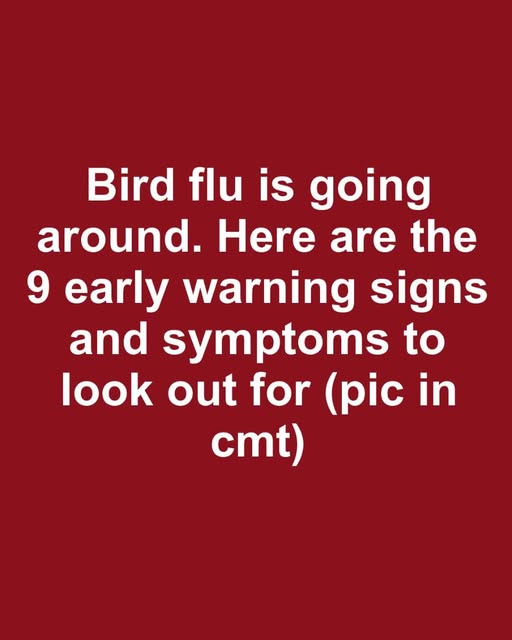
Bird flu, also known as avian influenza, is a highly contagious viral infection that primarily affects birds but has the potential to infect humans and other animals. While numerous strains of the virus exist, H5N1 and H7N9 are among the most dangerous to humans, often resulting in severe respiratory illness and, in some cases, death. Outbreaks have been reported worldwide, leading to massive poultry culling, trade restrictions, and economic losses. The potential of bird flu to evolve into a pandemic makes understanding the virus crucial for global public health preparedness.
The virus spreads mainly through direct contact with infected birds or their secretions, such as saliva, nasal fluids, and feces. It can also be transmitted indirectly via contaminated surfaces, including bird cages, clothing, and farm equipment. While human-to-human transmission remains rare, prolonged close contact—especially in high-risk environments like poultry farms—can increase the likelihood of infection. Migratory birds play a significant role in carrying the virus across borders, making containment efforts challenging. Strengthening biosecurity measures in poultry farms and live bird markets is essential to minimizing outbreaks.
Early detection of bird flu is critical in preventing widespread transmission. Recognizing symptoms at an early stage allows for timely medical intervention, reducing the severity of illness and improving recovery chances. Public health authorities rely on early identification to implement control measures such as quarantine, culling infected flocks, and travel advisories. Raising awareness about warning signs is particularly vital for individuals at higher risk, including poultry workers and those frequently exposed to birds.
In humans, bird flu symptoms can vary from mild to life-threatening and typically appear within two to eight days after exposure. The most common symptoms resemble seasonal flu, including fever, cough, sore throat, and muscle aches. However, in more severe cases, bird flu can lead to complications such as pneumonia, acute respiratory distress syndrome (ARDS), and multi-organ failure. Understanding these symptoms and seeking prompt medical attention can make a significant difference in patient outcomes.
Respiratory distress is one of the most concerning indicators of bird flu. Persistent coughing, shortness of breath, and chest pain can signal the progression of the virus into a severe lung infection. Left untreated, respiratory complications can escalate rapidly, requiring intensive medical care, including mechanical ventilation in critical cases. Anyone experiencing these symptoms, particularly after exposure to birds or affected areas, should seek immediate medical evaluation.
Although less common, gastrointestinal symptoms can also accompany bird flu infections. Nausea, vomiting, diarrhea, and abdominal pain may develop, increasing the risk of dehydration and other complications. These symptoms can sometimes be overlooked, but when combined with fever and respiratory issues, they strongly indicate the need for medical attention.
In rare instances, bird flu can affect the nervous system, leading to neurological symptoms such as confusion, seizures, and altered mental status. These signs often indicate severe disease progression and require urgent medical intervention. Neurological complications can have lasting effects, making it crucial to recognize and address them immediately.
Fever is a hallmark symptom of bird flu and is often accompanied by extreme fatigue and body aches. A sudden high fever, especially in individuals with known exposure to birds or affected areas, should raise concerns about possible infection. Fatigue and weakness can persist long after the fever subsides, making daily activities challenging. Monitoring body temperature and energy levels is key to detecting the disease early.
Muscle and joint pain are also common with bird flu, mimicking symptoms of other types of influenza. These aches can range from mild to severe, often exacerbating the overall discomfort of the illness. When combined with other flu-like symptoms, muscle pain can serve as an early warning sign of bird flu infection.
Certain individuals face a higher risk of developing severe complications from bird flu. These include poultry workers, individuals visiting live bird markets, and those in close contact with infected birds. Additionally, people with weakened immune systems, pregnant women, and young children are more vulnerable to serious illness. Understanding these risk factors is essential for taking preventive measures and reducing the likelihood of infection.
Seeking prompt medical attention is crucial for anyone experiencing bird flu symptoms, especially if they have had direct or indirect exposure to the virus. Early medical intervention can prevent complications and improve survival rates. Those with severe respiratory distress, persistent high fever, or neurological symptoms should seek emergency care immediately. Healthcare providers can conduct specialized tests to confirm the diagnosis and initiate antiviral treatment if necessary.
Preventing bird flu requires a combination of personal hygiene practices and broader biosecurity efforts. Avoiding contact with sick or dead birds, frequent handwashing, and using protective gear when handling poultry are essential steps in reducing risk. Vaccination programs for poultry, along with ongoing monitoring of bird populations, help control outbreaks before they escalate. Public health campaigns play a crucial role in educating communities about prevention strategies and reducing misinformation about the virus.
Bird flu remains a significant global health concern due to its potential for severe illness and large-scale outbreaks. Recognizing early symptoms, understanding transmission risks, and adopting preventive measures are key to mitigating its impact. Continued vigilance, research, and preparedness efforts will be necessary to protect both human and animal populations from future outbreaks. As the world continues to monitor the evolution of bird flu strains, proactive measures will be critical in preventing another pandemic and ensuring global health security.





